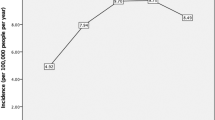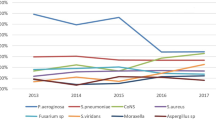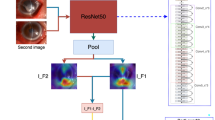Abstract
The investigation of presumed microbial keratitis includes microscopy and culture of corneal specimens obtained by scraping the infiltrated cornea. Routine microscopy fails to identify the infecting organism in about 15% of cases. We discuss the problems presented by 20 such eyes which required further investigation. We present a diagnostic algorithm aimed at reducing the delay in identifying the pathogen and increasing the rate of positive culture. This is important since unusual pathogens may require treatment with drugs other than the ‘first line’ broad spectrum combination of an aminoglycoside and a cephalosporin. The algorithm allows sequential restaining and reculturing of specimens for more thorough investigation. In addition to the use of special stains and culture conditions, it presents indications for further corneal scrapes and biopsies.
Uncontrolled infection resulted in five perforations and penetrating keratoplasty was indicated in 11 cases. The visual outcome for these patients was poor with fewer than 30% achieving 6/12 acuity. The delay in diagnosis increases morbidity and this should be significantly reduced by adopting the algorithm we propose.
Similar content being viewed by others
Log in or create a free account to read this content
Gain free access to this article, as well as selected content from this journal and more on nature.com
or
References
Jones DB : Decision-making in the management of microbial keratitis. Ophthalmology 1981; 88: 814–20.
Harris DJ, Stulting RD, Waring GO et al.: Late bacterial and fungal keratitis after corneal transplantation. Ophthalmology 1988; 95: 1450–7.
Schardt WM, Unsworth AC, Hayes CV : Corneal ulcer due to Nocardia asteroides. Am J Ophthalmol 1956; 42: 303–5.
Hirst LW, Harrison GK, Merz WG, Stark WJ : Nocardia asteroides keratitis. Br J Ophthalmol 1979; 63: 449–54.
Parsons MR, Holland EJ, Agapitos PJ : Nocardia asteroides keratitis associated with extended wear soft contact lenses. Can J Ophthaimol 1989; 24: 120–2.
Heathcote JG, McCartney ACE, Rice NSC et al.: Endophthalmitis caused by exogenous nocardial infection in a patient with Sjögren's syndrome. Can J Ophthalmol 1990 25: 29–33.
Newman PE, Goodman RA, Waring GO et al.: A cluster of cases of Mycobacterium chelonei keratitis associated with out-patient procedures. Am J Ophthalmol 1984; 97: 344–8.
Aylward GW, Stacey AR, Marsh RJ : Mycobacterium chelonei infection in a corneal graft. Br J Ophthalmol 1987; 71: 690–3.
Dugel PU, Holland GN, Brown HH et al.: Mycobacterium fortuitum keratitis. Am J Ophthalmol 1988; 105: 661–9.
Moore MB, McCulley JP, Newton C et al.: Acantha-moeba keratitis. A growing problem in soft and hard contact lens wearers. Ophthalmology 1987; 94: 1654–61.
Ficker LA : Acanthamoeba keratitis—the quest for a better prognosis. Eye 1988; 2: S37–45.
Roussel TJ, Osato MS, Wilhelmus KR : Capnocy-tophaga keratitis. Br J Ophthalmol 1985; 69: 187–8.
Heidemann DG, Pflugfelder SC, Kronish J et al.: Necrotizing keratitis caused by Capnocytophaga ochracea. Am J Ophthalmol 1988; 105: 655–60.
Eiferman RA, Levartovsky S, Box JD : Anaerobic Capnocytophaga corneal ulcer. Am J Ophthalmol 1988; 105: 427–?.
Stern GA, Hodes BL, Stock L : Clostridium per- fringens corneal ulcer. Arch Ophthalmol 1979; 97: 661–3.
Holbach LM and Bialasiewicz HJ . Necrotizing ring ulcer of the cornea caused by exogenous Listeria monocytogenes serotype IVb infection. Am J Ophthalmol 1989; 106: 105–7.
Kirkness CM, Seal DV, Clayton Y, Punithalingham E : Keratomycosis due to Sphaeropsis subglo-bosa—first reported case. Cornea 1991; 10: 85–9.
Rao NA : A laboratory approach to rapid diagnosis of ocular infections and prospects for the future. Am J Ophthalmol 1989; 107: 283–91.
Gomez JT, Robinson NM, Osato MS : Comparison of acridine orange and Gram stains in bacteria keratitis. Am J Ophthalmol 1988; 106: 735–7.
Ficker LA ., Seal DV, Wright P : Acanthamoeba keratitis—resistance to medical therapy. Eye 1990; 4: 835–8.
Handbook on Laboratory Methods: Commonwealth Mycological Institute Publications, Kew, England.
Newton C, Moore MB, Kaufman HE : Corneal biopsy in chronic keratitis. Arch Ophthalmol 1987; 105: 577–8.
Hill JC : Use of penetrating keratoplasty in acute bacterial keratitis. Br J Ophthalmol 1986; 70: 502–6.
Kirkness CM, Steele ADMcG, Rice NSC : Penetrating keratoplasty in the management of suppura-tive keratitis. Developments in Ophthalmology (Karger, Basel) 1990; 18: 172–5.
Donzis PB and Mondino BJ : Management of non-infectious corneal ulcers. Surv Ophthalmol 1987; 32: 94–110.
Stein RM, Clinch TE, Cohen EJ et al.: Infected versus sterile corneal infiltrates in contact lens wearers. Am J Ophthalmol 1988; 105: 632–6.
Rosenwasser GO, Holland S, Pflugfelder SC, Lugo M, Heidemann DG, Culbertson WW, Kattan H : Topical anaesthetic abuse. Ophthalmology 1990 97: 967–72.
Author information
Authors and Affiliations
Rights and permissions
About this article
Cite this article
Ficker, L., Kirkness, C., McCartney, A. et al. Microbial keratitis—the false negative. Eye 5, 549–559 (1991). https://doi.org/10.1038/eye.1991.97
Issue date:
DOI: https://doi.org/10.1038/eye.1991.97
This article is cited by
-
Diagnostic accuracy of confocal scan in detecting acanthamoeba keratitis and fungal keratitis: a systematic review and meta-analysis
International Ophthalmology (2023)
-
Corneal biopsy with tissue micro homogenisation for isolation of organisms in bacterial keratitis
Eye (1999)
-
Temperature-dependent resistance to gentamicin in graft keratitis by Stenotrophomonas (Xanthamonas) maltophilia
Eye (1997)
-
Severe microbial keratitis in temperate and tropical Western Australia
Eye (1996)
-
Criteria for intravitreal antibiotics during surgical removal of intraocular foreign bodies
Eye (1992)



